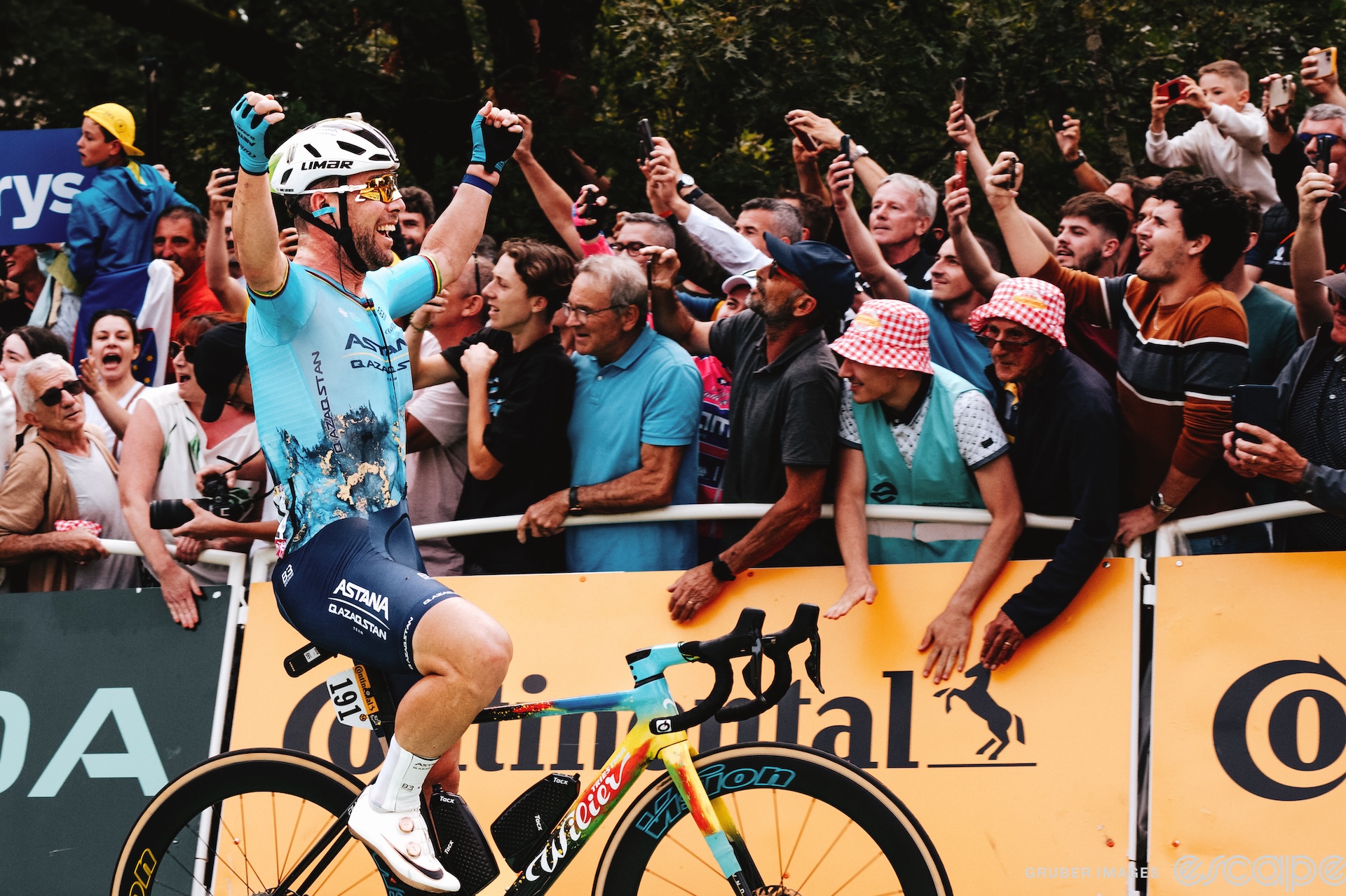As the Tour de France peloton sped towards the finish of stage 5 in Saint-Vulbas, a small train of Astana Qazaqstan riders maneuvered through the bunch to position Mark Cavendish for the impending sprint. The team had spent a significant sum of money and months of preparation to bolster the Manxman’s chances at taking a record-setting 35th Tour stage win, and this was a huge opportunity to make it all worth it.
Once Cavendish’s teammates had helped bring him towards the front of the pack, however, he looked for other wheels to follow. Rather than relying on a traditional lead-out train in the final kilometer, Cavendish decided to freelance in a what would prove to be a chaotic finale. Less than a minute later, he threw both hands in the air to celebrate the historic win.
As Cavendish himself later put it, “The boys improvised and got me there in the best position and I shot onto whatever train was going.” To achieve the victory, Cavendish decided to surf the wheels, and it worked: He weaved and sprinted his way to the stage win and a new record that seems likely to stand for a long, long time – the next-closest active rider in stage wins is Tadej Pogačar, well back with 12 victories.
A closer look at the final kilometer shows the greatest sprinter of all time delivering a master class of navigating the chaos of a bunch kick en route to victory that will be remembered for years to come.
With a clear sprint opportunity on tap, the speed was high and several teams were showing interest near the front in the last few kilometers of stage 5. Astana was one of the interested squads, with Cavendish (wearing number 191) sitting behind two teammates in light blue kit as the flamme rouge neared. Uno-X Mobility’s Jonas Abrahamsen hit the head of affairs with a kilometer to go, and then he gave way to DSM Firmenich-PostNL, riding for Fabio Jakobsen on the day. Behind, Cavendish momentarily lost touch with his lead-out.
Cavendish would draw up close to his teammates again a few moments later, but then he made the decision to weave to his right and into the slipstream of other lead-out riders and sprinters. From that point on, he would be freelancing in pursuit of the victory – and he expertly sought out the wheel of pre-stage favorite Jasper Philipsen (wearing number 106 for Alpecin-Deceuninck).
Perhaps unsurprisingly, Cavendish was not the only rider vying for Philipsen’s wheel, and he managed to stay upright despite a bit of contact with Movistar’s Fernando Gaviria to secure his position.
As Philipsen’s teammate Mathieu van der Poel did his final pull, several other riders surged past on the left of both Cavendish and Philipsen. When Lidl-Trek took over at the front with Israel-Premier Tech’s Pascal Ackermann just behind, Cavendish moved into the slipstream, maneuvering around Philipsen to get there. Going through a final curve, he pulled in front of Philipsen while still sheltered from the wind for a few final moments.
With 200 meters to go, Ackermann launched, and the rest of the sprinters responded immediately. Cavendish, in perfect position just behind, made his own bid for the line in a surge that took him from the right to the left side of the road. Within moments, and with only about a hundred meters left to cover, Cavendish exploded to the front of the race.
Behind, Philipsen moved onto Cavendish’s wheel. By this point, however, it was far too late for anyone to challenge the rider at the front of the race. No one was going to catch him.
When all was said and done, Cavendish’s teammates had helped deliver him into the final kilometer, and he handled the rest on his own, proving that racecraft and the instincts to follow the right wheels and to surge at the right moment were more than enough to put him into position to win. In the final 200 meters, he let his speed do the rest. Even at 39 years of age, three years removed from his last Tour stage win, Cavendish was imperious on the finishing straight.
He crossed the line with Philipsen still fully behind him, leaving no doubt about the victory that propelled him ahead of Eddy Merckx as the lone rider with more Tour de France stage wins than anyone in history.
What did you think of this story?


